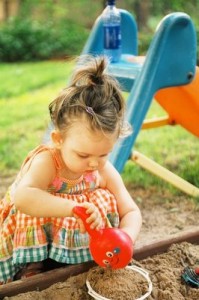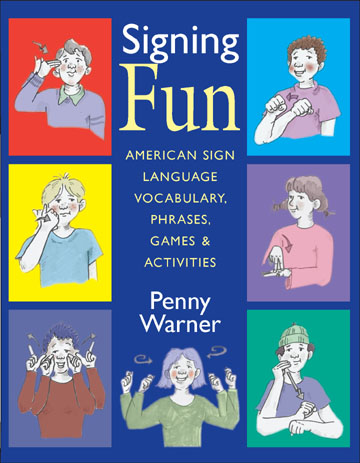Related Products
For Parents
Related Teacher Tools Takeout Items
Providing Early Intervention Services in Natural Environments
 Early intervention services are to be provided in natural environments to the maximum extent appropriate for the child and for the EI service itself.
Early intervention services are to be provided in natural environments to the maximum extent appropriate for the child and for the EI service itself.
So–what’s considered a “natural environment”? What isn’t? This webpage focuses upon answering these questions and on connecting you with resources of additional information and best practice.
- IDEA’s definition of “natural environment”
- Who decides where?
- Based on what?
- What must be included in the IFSP?
- Two points from the Department of Education
- Resources of more information
IDEA’s definition of “natural environment”
Part C of the Individuals with Disabilities Education Act (IDEA) requires that eligible infants and toddlers with disabilities receive needed early intervention services in natural environments to the maximum extent appropriate. The 2011 regulations for Part define the term as follows:
§303.26 Natural environments.
Natural environments means settings that are natural or typical for a same-aged infant or toddler without a disability, may include the home or community settings, and must be consistent with the provisions of §303.126.
That’s a straightforward, easily understood definition–with the exception of how it ends (“…must be consistent with the provisions of §303.126″). What might the provisions of §303.126 require?
Let’s have a look. Here they are:
§303.126 Early intervention services in natural environments.
Each system must include policies and procedures to ensure, consistent with §§303.13(a)(8) (early intervention services), 303.26 (natural environments), and 303.344(d)(1)(ii) (content of an IFSP), that early intervention services for infants and toddlers with disabilities are provided—
(a) To the maximum extent appropriate, in natural environments; and
(b) In settings other than the natural environment that are most appropriate, as determined by the parent and the IFSP Team, only when early intervention services cannot be achieved satisfactorily in a natural environment.
Combining these two sets of provisions makes it clear that early intervention services:
- must be provided in settings that are natural or typical for a same-aged infant or toddler without a disability to the maximum extent appropriate;
- may be provided in other settings only when the services cannot be achieved satisfactorily in a natural environment.
Who decides where services will be provided?
The Part C regulations also make it clear that the IFSP team determines the appropriate setting for providing early intervention services to a child or toddler. The IFSP team may determine that a service will not be provided in a natural environment only “when early intervention services cannot be achieved satisfactorily in a natural environment.”
Note | IFSP team refers broadly to the group of people who write the child’s individualized family service plan (IFSP). More specifically, as described in the Part C regulations:
- The child’s parents are members of the IFSP team. They may invite other family members to participate on the team as well (if it’s feasible to do so). They may also request an advocate or person from outside the family to participate on the team.
- The IFSP team must include two or more individuals from separate disciplines or professions, one of which must be the family’s service coordinator.
- The IFSP team must also include a person or persons directly involved in conducting the evaluations and assessments of the child and family.
- As appropriate, people who will be providing early intervention services to the child may also serve on the IFSP team. (§303.343)
This, then, is the group of well-informed individuals that makes the decision as to where early intervention services will be provided to the baby or toddler.
On what basis does the team decide the setting?
The short answer | The IFSP team decides where each EI service will be provided based on the measurable results or measurable outcomes expected to be achieved by the child. Those results or outcomes have been identified by the IFSP team and listed in the IFSP.
The longer answer | Again, the Part C regulations provide the necessary guidance. At §303.344(d)(1)(ii)(B), the regulations state:
(B) The determination of the appropriate setting for providing early intervention services to an infant or toddler with a disability, including any justification for not providing a particular early intervention service in the natural environment for that infant or toddler with a disability and service, must be—
(1) Made by the IFSP Team (which includes the parent and other team members);
(2) Consistent with the provisions in §§303.13(a)(8), 303.26, and 303.126; and
(3) Based on the child’s outcomes that are identified by the IFSP Team in paragraph (c) of this section… [emphasis added]
An example | The Department of Education provides an example of how it may not always be practicable or appropriate for an infant or toddler with a disability to receive an early intervention service in the natural environment based either on the nature of the service or the child’s specific outcomes. The Department states:
For example, the IFSP Team may determine that an eligible child needs to receive speech services in a clinical setting that serves only children with disabilities in order to meet a specific IFSP outcome. When the natural environment is not chosen with regard to an early intervention service, the IFSP Team must provide, in the IFSP, an appropriate justification for that decision. (76 Fed. Reg. at 60205)
What must be included about natural environments in the child’s IFSP?
The Part C regulations indicate that the IFSP must include:
…A statement that each early intervention service is provided in the natural environment for that child or service to the maximum extent appropriate …
or…
a justification as to why an early intervention service will not be provided in the natural environment. [§303.344(d)(1)(ii)(A)]
If the IFSP team determines that an early intervention service will not be provided in the natural environment, it must document in the IFSP the justification for why not–in other words, “why the alternative service setting is needed for the child to meet the developmental outcomes identified for the child in his or her IFSP” (76 Fed. Reg. at 60205).
Two points from the Department of Education
When the Department of Education released the 2011 Part C implementing regulations, it included the often fascinating Analysis of Comments and Changes. The Department’s discussion of “natural environments” includes two very interesting and illuminating observations we’d like to share with you.
Why not include a list of settings considered “natural environments” and those notconsidered “natural environments”? | The Department declined to add a fuller list of settings that may be considered (or would not be considered) “natural environments.” The current regulations only mention that natural environments “may include home and community settings.” Why did the Department decline including a fuller list? According to the Department:
“It would not be appropriate or practicable to include a list of every setting that may be the natural environment for a particular child or those settings that may not be natural environments in these regulations.
In some circumstances, a setting that is natural for one eligible child based on that child’s outcomes, family routines, or the nature of the service may not be natural for another child….
[T]he decision about whether an environment is the natural environment is an individualized decision made by an infant’s or toddler’s IFSP Team, which includes the parent…” (76 Fed. Reg. at 60157-60158)
Are clinics, hospitals, or a service provider’s office considered “natural environments”? | A very good question, you must admit! Here’s the Department’s response:
We appreciate the commenters’ requests for clarification as to whether clinics, hospitals, or a service provider’s office may be considered the natural environment in cases when specialized instrumentation or equipment that cannot be transported to the home is needed.
Natural environments mean settings that are natural or typical for an infant or toddler without a disability….We do not believe that a clinic, hospital or service provider’s office is a natural environment for an infant or toddler without a disability; therefore, such a setting would not be natural for an infant or toddler with a disability.
However, §303.344(d)(1) requires that the identification of the early intervention service needed, as well as the appropriate setting for providing each service to an infant or toddler with a disability, be individualized decisions made by the IFSP Team based on that child’s unique needs, family routines, and developmental outcomes. If a determination is made by the IFSP Team that, based on a review of all relevant information regarding the unique needs of the child, the child cannot satisfactorily achieve the identified early intervention outcomes in natural environments, then services could be provided in another environment (e.g. clinic, hospital, service provider’s office). In such cases, a justification must be included in the IFSP… (76 Fed. Reg. at 60158)
Resources of more information on natural environments
From NECTAC, the expert! | Early intervention services in natural environments.
A very sweet resource page! Be sure to visit and explore it.
http://www.nectac.org/topics/natenv/natenv.asp
Join a community of practice–or just explore what they offer.
This CoP is on Part C Settings–Services in Natural Environments, whose purpose is to share info and resources for improving practices in providing services and supports in natural environments.
http://www.tacommunities.org/community/view/id/1029
7 key principles: Looks like/Doesn’t look like.
http://www.nectac.org/~pdfs/topics/families/Principles_LooksLike_DoesntLookLike3_11_08.pdf
Early intervention in natural environments: A 5-component model.
http://www.cms-kids.com/providers/early_steps/training/documents/early_intervention.pdf
Top 10 mistakes in early intervention in natural environments—and the solutions.
http://www.waisman.wisc.edu/birthto3/Top_10Mistakes.pdf
Providing early intervention services in natural environments – Concerns and tips.
http://hpcswf.com/downloads/Providing%20EI%20Services%20in%20NE.pdf
This information has been included, with sincere appreciation, from the National Dissemination Center for Children with Disabilities website, which provided informational resources for over 20 years. Regrettably, funding from the Office of Special Education Programs (OSEP) at the U.S. Department of Education ended on September 30, 2013. Our thanks to the many individuals who compiled and created this useful information. Posted to Supporting Success for Children with Hearing Loss January 2014.

